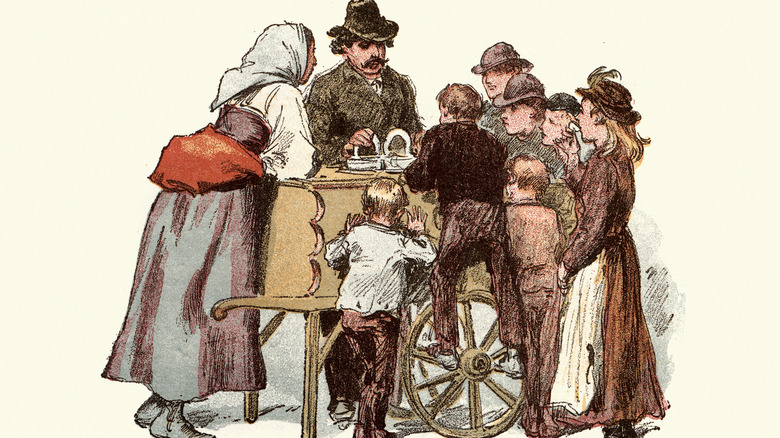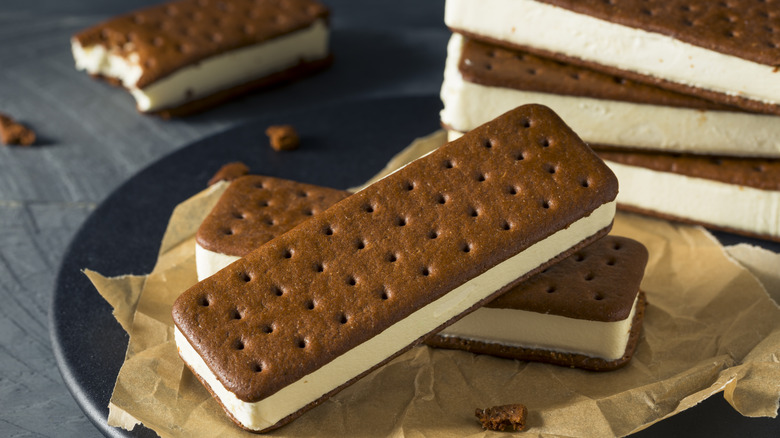How Ice Cream Was Served Before Cones Were Invented
The modern ice cream cone is such a common symbol of nostalgia and joy that it's hard to imagine a world without it. However, prior to 1904, ice cream enthusiasts had little choice but to use other vessels, since the iconic waffle cone hadn't been invented yet. Ancient Persians solved this problem by consuming fruit-flavored "sherbat" (the ancestor of modern sherbet) from bowls, as did King Charles II of England in 1671, when he sampled ice cream inspired by French and Italian frozen desserts.
As technology advanced, so, too, did the availability of ice cream. By the late 18th century, ice cream parlors had spread throughout London, England, serving up glass dishes of this trendy dessert in a host of flavors, including jasmine, pear, pine nut, and pumpkin. This era also saw the invention of ice cream molds shaped like realistic roses, lobsters, and pineapples. There was even a candle-shaped mold that came with a working wick that could be lit for a short time after the dessert was presented.
Stemmed metal cups were also popular ice cream vessels during this time, and artwork from the era depicted people enjoying ice cream from these cups using one of two methods. The first method utilizes a utensil that may be a spoon or a Victorian-era ice cream fork. The second involves holding the cup by its stem and licking the ice cream directly from the cup, similar to using a modern ice cream cone — though, of course, these vessels weren't edible.
How the Victorians enjoyed ice cream to go (and how it became illegal)
Despite the 19th century's penchant for producing beautiful ice cream vessels and clever flavors, this dessert had a dark side. While the upper classes enjoyed ice cream in private homes and upscale parlors, the lower classes relied on street vendors for a bit of this popular treat. This led to the popularization and eventual downfall of the notorious penny lick.
To make a penny lick, street vendors spooned a small portion of ice cream into a heavy-bottomed glass cup with a shallow depression in the center. The customer then licked the ice cream from the depression and handed the glass back. The vendor then refilled the same glass and handed it to another customer with barely a rinse or a wipe-down in between.
Though the Victorians had little to no concept of germ theory, they soon connected the sale of penny lick ice cream to the spread of diseases like cholera and tuberculosis, which led to the eventual ban of these dangerous little treats in 1899. Undeterred, London street vendors began copying their Italian contemporaries by hawking "hokey-pokey" in paper wrappers. This practice reduced the spread of disease, allowing London's lower classes to once again enjoy a cold treat on a hot day.
Edible ice cream vessels that came before the cone
Paper might have been more sanitary than penny lick cups, but it wasn't the sturdiest way to transport melting ice cream. As interest in paper-wrapped hokey-pokey waned in the early 1900s, ice cream sellers began to experiment with edible vessels. Precursors to the modern cone included squares of hard ice cream held between two wafers — the ancestor of today's ice cream sandwich — and a variety of cups and bowls molded from biscuit or pastry dough.
This idea became so popular that ice cream manufacturing partners Antonio Valvona and Italo Marchiony submitted patents in 1902 and 1903 for two different apparatuses for making edible ice cream cups. The inventions were designed to make multiple uniform cups at once, ensuring each customer received the same amount of ice cream. However, these and other edible vessels tended to become soggy and leak as the ice cream melted. It's really no wonder these vessels were abandoned when the waffle cone emerged during the 1904 World's Fair.
In the end, the waffle cone endured not only because of America's obsession with waffles, but also because it outperformed the edible alternatives. The batter recipe was relatively simple, it rolled into cones quickly and easily, and it could withstand ice cream's heft and moisture for much longer than the competition. This solidified its place in the cultural zeitgeist — so much so that we keep inventing different ways to use ice cream cones to enjoy them more often.


